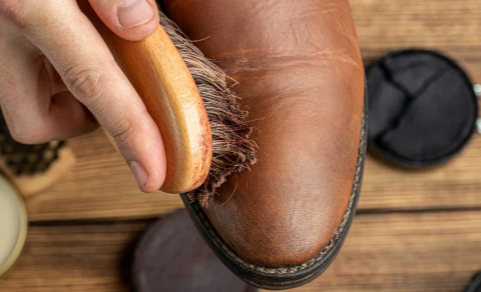Care Tips for Your Boots: Cleaning, Conditioning, and Storage

Key Takeaways
- Consistent care preserves your boots’ shine, structure, and overall appeal.
- Regular cleaning, conditioning, and waterproofing prevent damage and extend lifespan.
- Proper storage and maintenance checks reduce costly repairs and replacements.
- Investing a little time in boot care saves money while keeping your footwear stylish and comfortable.
Introduction
Whether you wear boots for style, work, or comfort, a little care keeps them looking their best. In today’s fast-paced world, it can be tempting to neglect footwear maintenance, but the benefits of upkeep are well worth the small time investment. With the right habits, you can ensure your boots maintain their original appeal through countless wears, preserving shine, color, and structure. Aside from keeping your boots looking fresh, routine maintenance also offers significant savings by lengthening their life and reducing the need for frequent replacements. Well-cared-for boots rarely suffer cracks or irreparable stains, often lasting for many years, even decades. If you want to step out in style and maximize value, following a proper care regimen is essential. You can also explore comfortable women’s footwear that blends style with practicality, which makes regular care even more rewarding by prolonging comfort and wearability.
This comprehensive guide teaches you how to clean, condition, waterproof, and store your boots properly—tailored to different materials and uses. Integrating just a few simple steps into your routine lets you keep every pair looking new, no matter the season. Taking the time to treat your boots well showcases your attention to detail and lets you get the most out of every pair you own.
Cleaning Your Boots
Dirt and debris might seem trivial, but they wear down the materials over time and diminish your boots’ overall appearance. Even a thin layer of dust can draw moisture away from leather or suede, leading to premature aging and damage. Different materials require different cleaning techniques, so it’s important to identify your boot’s composition before diving in. By tailoring your approach, you prevent accidental damage and ensure each material maintains its natural properties and appearance.
Leather Boots
Wipe leather boots with a damp cloth to remove daily dust and grime. Consistent attention to surface cleanliness prevents the accumulation of residues that can dull their finish. For deeper cleaning, use a soft brush with a mild leather cleanser—never household soap, as it strips vital oils from the leather, leaving it brittle and prone to cracking. Persistent stains may need a specialized product designed for leather surfaces, such as saddle soap or a stain remover, applied according to the manufacturer’s instructions to avoid over-treating the leather.
Suede Boots
Use a dedicated suede brush to gently lift away surface dirt, always brushing toward the fabric’s nap. If you encounter marks, gently rub them with a suede eraser or a soft, lint-free cloth dampened slightly with white vinegar. This method helps remove blemishes without saturating the sensitive suede. After cleaning, brush the suede again to restore its signature texture, keeping the fibers upright and the appearance plush and sophisticated. Regular gentle brushing prevents significant buildup, which can be much harder to remove once embedded.
Conditioning Leather Boots
Proper conditioning prevents the leather from drying, cracking, or losing its suppleness. When leather dries out, it can lead to permanent scarring and weakened structure, decreasing both comfort and durability. Conditioning replenishes essential natural oils, restoring flexibility and helping fend off everyday abrasions. It’s especially important if you live in a dry climate or wear your leather boots frequently, as both factors accelerate moisture depletion from the hide.
- Once cleaned and fully air-dried, apply a high-quality leather conditioner using a soft, circular motion to ensure even coverage and maximum penetration.
- Allow the product to soak in for at least an hour to ensure the leather absorbs the necessary moisture. This will give time for the nutrients to restore the fibers from within.
- Gently buff any excess conditioner with a clean, soft cloth for a lasting shine and protection, ensuring no sticky residue remains on the surface.
For best results, repeat this process every two to three months, especially if you wear your boots frequently or live in a dry climate. Skipping conditioning leads to stiffness, cracking, and a dull appearance, so don’t neglect this step if you want to keep your boots supple and vibrant over the years.
Waterproofing Your Boots
Keeping boots dry is fundamental for longevity and comfort, especially in climates prone to rain or snow. Applying a moisture barrier prevents stains, warping, and salt damage that often plague boots exposed to harsh weather. Even boots labeled “weatherproof” benefit from an occasional fresh layer of protection, particularly after long-term use.
- Leather Boots: Choose a waterproofing wax or spray specifically formulated for leather to avoid clogging pores or altering the finish. Always test the product on a small, inconspicuous area first. After application, let the boots dry completely before the next wear to allow the protective layer to set, blocking moisture without sacrificing breathability.
- Suede Boots: To maintain the soft, matte texture of suede, use a spray tailored to the material. Never use wax or silicone-based sprays, which can harden or discolor the material, permanently changing the look and feel of the suede. Apply light, even coats and allow the boots to dry naturally in direct sunlight.
Proper Storage Practices
Proper storage dramatically extends the lifespan of your boots by maintaining structure and preventing environmental damage. Before storing, always ensure that boots are thoroughly clean and dry to eliminate the risk of mold, mildew, and unpleasant odors. Neglecting this can lead to lasting odors and even material breakdown, making recovery impossible.
- Use Boot Trees: Inserting boot trees or stuffing boots with acid-free paper preserves their shape and wards off creasing around the ankle and toe box. These supports help maintain the integrity of the boot, ensuring they look as good coming out of storage as they did going in.
- Climate Control: Store boots in a cool, dry place, away from direct sunlight or heating vents. Excess heat and light can dry out materials and fade colors, causing them to look old before their time.
In addition to structure and moisture control, experts at Wirecutter by The New York Times recommend using a breathable storage container or dust bag to further protect from dust and environmental pollutants. Avoid stacking boots, which can cause them to lose shape or develop pressure marks.
Regular Maintenance Checks
- Soles and Heels: Examine your boots regularly for thinning or damage to the soles and heels, which can be hazardous and shorten the boot’s life. If necessary, have them resoled by a professional, as replacing soles is generally much more affordable than purchasing a new pair of boots.
- Stitching: Watch for unraveling threads and reinforce them to keep water and dirt at bay, preventing leaks and additional structural problems.
- Insoles: Replace worn-out insoles to ensure comfort and support with every step. Fresh insoles also help control foot odor and prolong the boot’s inner structure.
Additional Tips
- Rotate Your Boots: Allowing each pair to rest between wears reduces sweat buildup and offers the materials time to recover, preventing accelerated wear. This practice extends the lifespan of your collection and gives you more style options throughout the week.
- Use a Shoe Horn: Use a shoe horn every time you put your boots on to minimize pressure on the heel cup and seams. This simple tool helps maintain the shape and structure over time, putting less stress on the material with each wear.
- Address Spills Immediately: Blot spills promptly to prevent permanent stains or watermarks. Never use a hairdryer or direct heat; it can cause irreparable damage. Always let boots air dry naturally, using absorbent paper towels for excess moisture as needed.
Final Thoughts
Caring for your boots is a simple way to protect your investment and keep your footwear fashionable and functional. Making cleaning, conditioning, waterproofing, and proper storage a habit ensures that your favorite pairs remain comfortable and sturdy for years to come. Routine attention also means fewer expensive repairs, a more impressive wardrobe, and proudly wearing boots that look as good as new. With regular attention and extra care, you’ll keep each step as fresh as the first.




